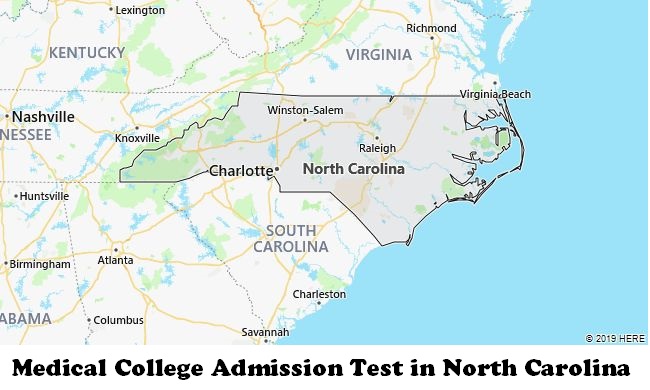According to AAMC (the MCAT test maker), there are 8 MCAT test centers in North Carolina. Most testing centers are located inside a college or university. You can select a testing location that is nearest to you. Please note that you are able to choose a test center when registering for the MCAT.

Asheville – College Place
31 COLLEGE PLACE BLDG D.
SUITE 107
ASHEVILLE, NC 28801
ETS – APPALACHIAN STATE UNIV.
287 Rivers St., Rm. 245
John E. Thomas (JET) Bldg
Boone, NC 28608
Charlotte – Coliseum Centre Drive
2815 COLISEUM CENTRE DRIVE
BUILDING 6, SUITE 160
CHARLOTTE, NC 28217
ETS – NC CENTRAL UNIVERSITY
1801 FAYETTVILLE ST.
L.T. WALKER COMPLEX ROOM C304
DURHAM, NC 27707
Greensboro – Centerview Drive
3 CENTERVIEW DRIVE
SUITE 248
GREENSBORO, NC 27407
Greenville – WH Smith Boulevard
1011 W.H. Smith Blvd.
Suite 102
Greenville, NC 27834
Raleigh – Spring Forest Road
3200 SPRING FOREST ROAD
SUITE 212
RALEIGH, NC 27616
Wilmington – Randall Parkway
4900 RANDALL PARKWAY
BLDG. A
WILMINGTON, NC 28403

Modern History of the State of North Carolina
In the second half of the 18th century, the population of North Carolina (as well as the residents of the other twelve North American colonies) was very dissatisfied with the policies of the metropolis. In the province, the movement of the “Sons of Liberty” was gaining strength, striving for independence. From 1774 to 1776, the North Carolina Provincial Congress met five times, independent of the British crown. In 1775, the “committees of security” created on the recommendation of the First Continental Congress effectively replaced local governments, and the “Council of Security” approved by the Provincial Congress began to perform the functions of government. Among historians, there is a version according to which on May 20, 1775 in Charlotte, a committee of citizens adopted the so-called “Mecklenburg Declaration” (after the name of the district), which more than a year before the adoption of the Declaration of Independence of the United States proclaimed the independence of the province from Great Britain. There is no reliable evidence of the existence of such a document, but, nevertheless, the date of its adoption is depicted on the coat of arms and flag of North Carolina.
On April 12, 1776, the Fourth Congress of North Carolina passed the so-called “Halifax Resolutions” (named after the city where the meetings were held). This ordinance empowered delegates traveling from the province to the Second Continental Congress to vote in favor of declaring independence. The “Halifax Resolutions” were the first such document in the colonies striving for independence, the date of their adoption is also immortalized on the official symbols of the state.
During the years of the American Revolutionary War in North Carolina, there was a fierce guerrilla war between patriots (supporters of independence) and loyalists (adherents of the English king). In the years 1780-1781, several skirmishes took place in the state between the Continental Army and British troops, known as the “Carolinska Company”. One of the largest was the Battle of Guildford Court House (near the modern city of Greensboro), which took place on March 15, 1781. Although the battlefield remained with the British, they suffered such significant losses that their victory turned out to be “pyrrhic”.
After much debate between the Federalists (supporters of a strong nationwide U.S. government) and their opponents, on November 21, 1789, North Carolina ratified the Constitution of the United States of America, thus becoming the twelfth state of the United States.
